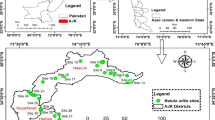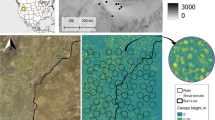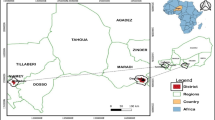Abstract
For the first time, mathematical methods are used to assess the restoration of secondary virgin lands on dry-steppe fallow lands under the influence of artificial protective forest stands, a mandatory component of modern agroforest landscapes. Using variance analysis, Spearman’s rank correlation coefficient, and the method of correlation pleiades, it is established that artificial stands significantly affect the species composition of plant communities. The greatest impact of cluster forest stands on the species composition of plant communities is observed in their immediate vicinity. The study objects located far from the forest stands feature the maximum similarity coefficients with the virgin lands. It is shown that fallow lands in edge zones of artificial stands planted in a linear fashion are similar to phytocoenoses of adjacent areas by their species composition.




Similar content being viewed by others
REFERENCES
Abaimov, V.F., Ledovskii, N.V., and Khodyachikh, N.V., Demutational processes of vegetation on fallow lands in the dry steppe zone of the Southern Urals, Izv. Orenburg. Gos. Agrarn. Univ., 2012, no. 3 (35), pp. 73–75.
Aleksandrova, V.D., Izuchenie smen rastitel’nogo pokrova (Study of Changes in Vegetation Cover), Moscow: Nauka, 1964, vol. 3, рр. 300–447.
Byalt, V.V., Sagalaev, V.A., and Firsov, G.A., Natural and adventive dendroflora of the Nizhnekhopersky Natural Park, Byul. Glav. Bot. Sada, 2012, no. 3, pp. 35–45.
Cherepanov, S.K., Sosudistye rasteniya Rossii i sopredel’nykh gosudarstv (v predelakh byvshego SSSR) (Vascular Plants of Russia and Neighboring Countries (Within the Former USSR)), St. Petersburg: Mir i sem’ya, 1995.
Gusev, A.P., Successional system as the basis for phytoindication of landscape dynamics (an example from Polesie landscape province), Prir. Resur., 2008, no. 2, pp. 51–62.
Gusev, A.P., Specific features of early stages of progressive succession in an anthropogenic landscape: an example from southeastern Belarus), Russ. J. Ecol., 2009, vol. 40, no. 3, pp. 160–165.
Gusev, A.P., Features of vegetation successions in landscapes disturbed by human activities (an example from southeastern Belarus), Sib. Ekol. Zh., 2012, no. 2, pp. 231–236.
Gusev, A.P., Anthropogenic transformation of landscapes and vegetation successions, Vestn. Tyumen. Gos. Univ., Ser. Ekol. Prirodopol’z., 2015, vol. 1, no. 2 (2), pp. 103–110.
Ivanov, A.L., Sustainable use and protection of land (soil) resources of the Russian Federation, Vestn. Ross. S.-Kh. Nauki, 2015, no. 1, pp. 7–10.
Kazantseva, T.I., Bobrovskaya, I.I., and Tishchenko, V.V., Features of the restoration of fallow vegetation in meadow steppes of the Central Chernozem region (Voronezh oblast), Arid. Ekosist., 2010, vol. 16, no. 2 (42), pp. 76–78.
Kotlyarova, E.G., Expansion of biological diversity in landscape systems, Zemledelie, 2008, no. 2, pp. 21–24.
Kulik, K.N. and Pugacheva, A.M., The structure of plant communities of fallow land in the system of protective forest plantations in dry steppes, Arid. Ecosyst., 2016, vol. 6, no. 1, pp. 63–69.
Kulik, K.N., Ivanov, A.L., Rulev, A.S., Svintsov, I.P., Pavlovskii, E.S., Petrov, V.I., Barabanov, A.T., Manaenkov, A.S., Vasil’ev, Yu.I., Zhdanov, Yu.M., Zykov, I.G., Kulik, N.F., Kryuchkov, S.N., Malanina, Z.I., Semenyutina, A.V., Sukhorukikh, Yu.I., Shul’ga, V.D., and Yuferev, V.G., Strategiya razvitiya zashchitnogo lesorazvedeniya v Rossiiskoi Federatsii na period do 2025 goda (Development Strategy for Protective Afforestation in the Russian Federation for the Period up to 2025), Volgograd: VNIALMI, 2018.
Levykin, S.V., Features of generative activity of steppe phytocenoses, Izv. Orenburg. Gos. Agrar. Univ., 2006, vol. 3, no. 11-1, pp. 151–153.
Metodika sistemnykh issledovanii lesoagrarnykh landshaftov (Methodology for Systemic Research of Forest–Agricultural Landscapes), Moscow: VASKhNIL, 1985.
Mirkin, B.M., Naumova, L.G., and Solomeshch, A.I., Sovremennaya nauka o rastitel’nosti: uchebnik (Modern Vegetation Science: A Textbook), Moscow: Logos, 2001.
Natsional’naya strategiya sokhraneniya bioraznoobraziya Rossii (National Strategy for Biodiversity Conservation in Russia), Moscow: Ross. Akad. Nauk, Min. Prir. Resur. Ross. Fed., 2001.
Orlov, D.S. and Biryukova, O.N., Carbon reserves in organic compounds in soils of the Russian Federation, Pochvovedenie, 1995, no. 1, pp. 21–32.
Parshutina, L.P., Steppes of the western boundary of the Lower Volga region (Volgograd oblast), Bot. Zh., 2015, vol. 100, no. 9, pp. 886–908.
Programma i metodika biotsenoticheskikh issledovanii (Program and Methodology of Biocenotic Research), Dylis, D.F., Ed., Moscow: Nauka, 1974.
Pugacheva, A.M., Successions of fallow vegetation under the influence of linear protective plantations (an example of the south of the Volga Upland), Probl. Region. Ekol., 2015, no. 1, pp. 44–47.
Rulev, A.S. and Pugacheva, A.M., Soil-geomorphological studies of landscapes in the South of the Caspian Upland, Agrarn. Nauch. Zh., 2014, no. 12, pp. 30–33.
Safronova, I.N., Can a subzone of desertified steppes be called an ecotone?, Arid. Ekosist., 2006, vol. 12, nos. 30–31, pp. 20–27.
Sazhin, A.N., Kulik, K.N., and Vasil’ev, Yu.I., Pogoda i klimat Volgogradskoi oblasti (Weather and Climate of the Volgograd Oblast), 2nd ed. (rev., ext.), Volgograd: FNTs Agroekol. Ross. Akad. Nauk, 2017.
Sergeeva, I.V., Shevchenko, E.N., and Zyabirova, M.M., Features of flora and vegetation of uneven-aged fallow lands in the southern part of the Volga Upland of the Saratov oblast, Agrarn. Nauch. Zh., 2015, no. 10, pp. 26–28.
Shmidt, V.M., Matematicheskie metody v botanike: uchebnoe posobie (Mathematical Methods in Botany: A Textbook), Leningrad: Leningr. Gos. Univ., 1984.
Smelyanskii, I.E., How many fallow lands are there in the steppe region of Russia?, Step. Byull., 2012, no. 36, pp. 4–7.
Terent’ev, P.V., Method of correlation pleiades, Vestn. Leningr. Univ., 1959, no. 9, pp. 137–141.
Titlyanova, A.A. and Sambuu, A.D., Determinacy and synchronicity of fallow succession in the Tuva steppes, Biol. Bull. (Moscow), 2014, vol. 41, no. 6, pp. 545–553.
Titlyanova, A.A., Afanas’ev, N.A., Naumova, N.B., Andrievskii, B.C., Artamonova, V.S., Bulavko, G.I., Gantimurova, N.I., Kosinova, L.Yu., Kosykh, N.P., Mironycheva-Tokareva, N.P., Mordkovich, G.D., Naumov, A.V., Naprasnikova, E.V., Polovinko, G.P., Stebaeva, S.K., and Yakutin, M.V., Suktsessii i biologicheskii krugovorot (Successions and Biological Circulation), Novosibirsk: Nauka Sibirskaya izdatel’skaya firma, 1993.
Author information
Authors and Affiliations
Corresponding author
Ethics declarations
The author declares that she has no conflict of interest. This article does not contain any studies involving animals or human participants performed by the author.
Additional information
Translated by L. Emeliyanov
Rights and permissions
About this article
Cite this article
Pugacheva, A.M. Effects Exercised by Artificial Forest Stands on the Restoration of Secondary Virgin Lands in Agroforest Landscapes of Dry Steppes. Biol Bull Russ Acad Sci 48, 199–206 (2021). https://doi.org/10.1134/S1062359021020096
Received:
Revised:
Accepted:
Published:
Issue Date:
DOI: https://doi.org/10.1134/S1062359021020096




